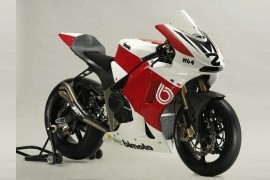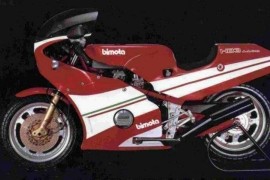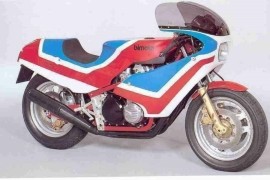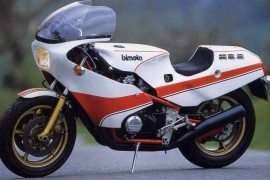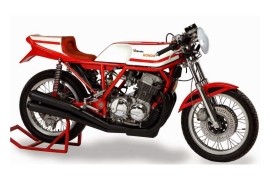BIMOTA HB Models/Series Timeline, Specifications & Photos
First production year: 1974
The 2010 MY Bimota HB4 Moto2 has, at its heart, a liquid-cooled, four-stroke, in-line four cylinder powerplant mated to a six-speed manual transmission. It also comes with a 43mm Paioli upside-down fork, an Ohlins TTX adjustable mono-shock as a rear suspension, a Brembo braking system with front and rear disc brakes, blacked-out, forged-magnesium wheels, a full-fairing, a single seat, a small windscreen, a digital instrumentation panel, and a frame that has both steel and cast-magnesium parts. This new Bimota is named HB4, as it’s the fourth Bimota powered by a Honda engine—in this case, the CBR600RR derivative developed for new Moto2 class.
The 1985 MY Bimota HB3-S is a race-oriented machine that comes standard with features such as a Brembo braking system with dual front discs, an aerodynamic, full-fairing, a large windscreen, cast-aluminium wheels, a single seat, a dual exhaust system, plus a high-end suspension package composed of a 40mm Italia telescopic fork with magnesium tubes and an adjustable De Carbon mono-shock in the rear.
In the tech/engine department it sports an air/oil-cooled, four-stroke, 1062cc, transverse four cylinder powerplant mated to a five-speed manual transmission, and can reach a maximum power output of 115 horsepower and 100 Nm of torque.
The 1983 MY Bimota HB3 has, at its heart, an air/oil-cooled, four-stroke, 1062cc, transverse four cylinder powerplant paired to a five-speed manual transmission, and can reach a maximum power output of 115 horsepower and 100 Nm of torque.
It also comes standard with a 40mm Italia telescopic fork with magnesium tubes, a De Carbon adjustable shock absorber in the rear, a Brembo braking system with dual discs in the front, a full-fairing, a large windscreen, a single seat, cast-aluminium wheels, a dual exhaust system, an analogue instrument cluster, plus a race-inspired paint and graphic scheme.
The 1982 MY Bimota HB2 sports an air-cooled, four-stroke, 901cc, transverse four cylinder engine paired to a five-speed manual transmission, that can produce a claimed 95 horsepower and 77 Nm of torque. It also comes standard with features such as an Italia telescopic fork in the front with magnesium tubes, an adjustable De Carbon shock absorber in the rear, cast-aluminium wheels, a single seat, a full-fairing, a windscreen, a dual exhaust system, dual front disc brakes and a single rear one, plus an analogue instrument cluster.
The 1975 MY Bimota HB1 has, at its heart, an air/oil-cooled, four-stroke, 736cc, transverse four cylinder powerhouse mated to a five-speed manual transmission, and can produce a claimed 69 horsepower and 8000 rpm. It also boasts a dual exhaust system with dual mufflers, dual Marzocchi shock absorbers as a rear suspension, a Ceriani telescopic front fork, a braking system with dual discs in the front, an analogue instrument cluster, and aluminium wheels. It is estimated that only 10 units of this machine has been produced, and was created with the sole purpose of being used on the race track.
